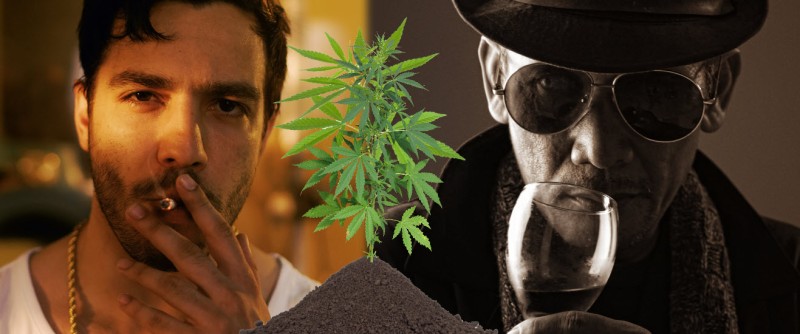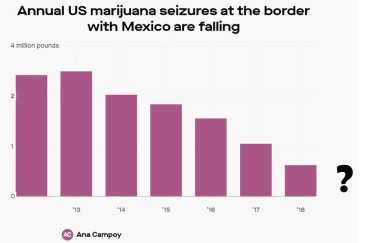
While there are many reasons for legalization, one of the core promises of drug legalization is to negatively impact the bottom line of drug cartels. Now that we have seen some forms of legalization play out over the past two decades – perhaps its time we begin to look into how the Mexican Drug Cartel has evolved within the ever changing landscape of drug policy.
An in-depth article from “InsightCrime.Org” looks at the past decade of Cartel activity and reveals how the cartels have adapted their approach to dealing with marijuana. Within the report, we have a clear picture on how cannabis legalization has impacted their operations within the US and Mexico.
Throughout the rest of this article I’ll highlight some of the most important findings of the report and explain why drug legalization is essentially the only clear-cut way to reduce the risk of “tainted drugs”, and to essentially “declaw” drug cartels.
The fact of the matter is that we have evidence in the past of this strategy working with alcohol prohibition. Many of the “illicit mafias” warped into legitimate businesses who needed to be regulated by the state.
One of the main reasons why alcohol prohibition was nullified was due to the excessive violence that spurred from prohibition. Booze Mafias, similar to the drug cartels of the modern era would frequently fight for market dominance.
However, when you’re operating in a market that isn’t publically “acceptable” – it means that instead of hiring lawyers to “battle out corporate disputes”, you’d rather buy a Tommy Gun and rain pure hellfire on your competition.
Yet, it only took a few years for these murderous rampages to die out post-alcohol reintegration. This is something that can be achieved with drug cartel organizations as well – however, it also won’t be a “day and night” ordeal.
For over fifty years, the governments of the world have literally “waged war on drugs” and as of writing this article the world has more drugs readily available than ever! The only thing that drug prohibition achieved is create criminal organization that over shadows the 1920s Mafia one hundred fold and expands its reach into transnational spaces.
Within any rational setting, this would mark the attempt at “prohibiting drugs” a complete failure – yet, as we come near the end of the year 2022, we’re still seeing politicians peddle in Reefer Madness. We’re still “waiting for the science” to catch up and tell us that cannabis isn’t so bad after all.
Nonetheless, the grass roots movements across the world has already showed us that legalization and regulation can help bring order to the illicit drug trade. It shows us that the average consumer would much rather participate in a legal market space and that there isn’t any significant risk from full scale legalization.
While all of these questions are fascinating to examine – we’re going to take a closer look at how cannabis legalization has warped cartel activity.
How Cannabis Legalization Warped Cartels
To read the full Study you can get it here.
At the beginning of the War on Drugs in 1971, the vast majority of cannabis consumed in the US came from Mexico. Not all the cannabis came from Mexico, some were locally sourced, but it wasn’t until later that the “Emerald Triangle” truly were known for producing the best weed.
It took a few decades for those mountain hippies to perfect their techniques and stabilize genetics, and as a result, the vast majority of cannabis came from Mexico.
This was also known to the prohibition crowd who utilized the word “marijuana” to demonize cannabis. Irrespective of the demonization of “marijuana”, most weed consumed in the US came from Mexico. This was up until 2010 when things broke even;
In 2010, the RAND Corporation said it was “noncontroversial” to declare that at least 50 percent of the marijuana consumed in the United States was produced in Mexico. At the time, there were but 11 states that had granted some legal access to marijuana, and by all indications, Mexico’s production was booming. In 2009, US authorities along the southwest border seized some 1.5 million kilograms of marijuana, up from about one million kilograms in 2005. Even so, RAND could see the tide was shifting and predicted, correctly it seems, that the coming legalization of marijuana in states like California would significantly cut into Mexican DTO’s earnings.
RAND’s argument was based on two key factors: potency and price. In terms of potency, RAND said, US legal marijuana was about 300 percent more potent on average than Mexican-produced marijuana. And while the price point for this marijuana was as much as 50 percent higher, the potency more than made up for this difference. Even if legalization was restricted to California, RAND said, its impact on Mexican criminal organization’s market share would be significant. “We believe that legalizing marijuana in California would effectively eliminate Mexican DTOs’ revenues from supplying Mexican-grown marijuana to the California market,” RAND researchers wrote, limiting their prediction to the state they’d chosen to study but with obvious implications beyond.
SOURCE: InsightCrime
The RAND Corporation hit the nail right on the head. In 2022, people are more picky about their weed consumption than ever before. In 2005, you would buy a seedy bag of weed with the odd chicken feather stuck in it and be happy. This was the way that weed looked!
However, after the hippies in the Emerald Triangle started stabilizing genetics like Kush and so forth, the weed game changed forever.
It took roughly 4 decades after the people in Humboldt started doing their weed experiments for the global market to shift towards better standards.
Seedy, terpeneless weed simply wouldn’t do it!
The average consumer today has some notion that there are “different type of weed” some that makes you high and some that knocks you out.
The average consumer understands that you can buy a vape pen with activated THC in it. They know about extracts, edibles and a range of other cannabis related products.
Therefore, when the Cartels didn’t “update” their product according to the new Humboldt standard – there was a massive drop in cannabis purchases as a result. People simply preferred to spend more money on quality than quantity and on average the price of American weed was 300% more expensive than its Mexican counterparts.
Irrespective of this price surge, people still preferred American weed and as a result, the market share of cartels have dropped significantly. It went from roughly 50% in 2010, to about 25% in 2022 with most of the cannabis being shipped via Texas.
The supply towards California and Arizona has essentially dried up since people are simply not buying Mexican grown weed in those states. However, the supply of Cartel weed is still going towards places that have prohibition on the books but as more states legalize, even this will eventually dry up.
How the Cartels are Evolving as a Result
In order to mitigate the loss of revenue, the Crime Insight report identifies three main strategies that the Cartels have been possibly using to keep their profit margins high. In this section we’ll briefly touch on all three.
Strategy 1: Supplying to Limited US areas and expand to other international markets
As mentioned, there isn’t really anyone in California who wants to buy “Mexican Shwag” when there’s home grown available. Not to mention, while there is a significant presence of legal cannabis dispensaries in these markets, it’s the “grey market” that is the biggest competition to the cartels.
Grey Markets are independent grows happening in the US.
While some claim that cartels are buying up land in the US and growing there, there isn’t much evidence supported by this as stated in the report;
And while news reports, often quoting officials, say Mexican “cartels” are buying up land and growing large amounts of marijuana to distribute in the US, neither the officials nor the news organizations offer any evidence to back up those claims. The DEA did not respond to any of InSight Crime’s requests for comment, and local Fish and Wildlife officials in California said they haven’t found any evidence so far to suggest connections between illegal cannabis cultivation and Mexican drug trafficking organizations.
SOURCE: CrimeInsights
Rather, the main competition for the cartels come from these “independent US grows” within the Grey Market that is able to produce higher quality cannabis, several times per year, reducing the cost of shipping and being able to compete with legal markets.
Local and federal authorities also say there are hundreds of so-called “outlaw grows” in the United States. The problem is particularly acute in places like California, where a recent Los Angeles Times’ investigation uncovered hundreds of unregistered “hoop houses,” which can produce three to five harvests a year. And with over half the US population residing in areas where marijuana is legally available in some form, diversion and illegal grows will remain a central issue.
SOURCE: CrimeInsights
This is an issue for both Law Enforcement and Cartels alike and it seems that neither Law Enforcement nor the Cartels have any clear solutions on dealing with this issue.
One way the Cartels are dealing with the issue is by trying to find other international markets such as Latin America, Europe and even in some cases Africa.
There is also evidence to suggest that Mexican organized crime groups may be trying to find new international marijuana markets. Last year, authorities seized more than 1,700 kilograms of marijuana destined for Chile from a shipping container at the Port of Manzanillo in the state of Colima. Days later, Chile’s armed forces seized more than a ton of marijuana sent from the Port of Lázaro Cárdenas in Michoacán state. Both Pacific coast states are home to a smattering of criminal groups, but it would take a sophisticated operation to organize international shipments of this size.
SOURCE: CrimeInsights
Of course, the profit margins are not as beefy as in the US, but for the Cartels with their massive infrastructure who produces tons of cannabis per year – the weed has to go somewhere, even at a loss of profits.
Strategy 2: Expanding into Mexico’s Market
Mexico has been “on the verge” of legalizing for the better part of five years now, however – the market is poised to become an international force. In fact, the Mexican cannabis consumer (who was very low in relation to the rest of the population) has doubled in prevalence.
The estimated percentage of users among the general population has steadily increased from 1.2 percent reporting having consumed marijuana during the last year in 2011, to 2.1 percent in 2016. Adolescents are one of the age groups with the sharpest growth, moving from 2.4 percent reporting having consumed marijuana during 2011, to 5.3 percent in 2016.
SOURCE: CrimeInsights
In markets such as Mexico City and Guadalajara, the cannabis market has evolved in a similar manner as the US and now concepts like Extracts, infusions, budder, wax, etc – are all commonly available. In fact, dealers now offer menus with different strain types and mostly focus on upper-middle class consumers who are buying the cannabis at a marginally lower price than in the US.
For example, high quality cannabis can cost up to $170 USD per Ounce however, the median price still lingers roughly around the $75-$100 price point. Considering that in Mexico the minimum daily wage is $10 USD per day, the price point is actually quite elevated.
Furthermore, Mexican growers are becoming more sophisticated and are now able to produce similar quality to markets such as California. This has turned their focus on Mexican wellness markets and it seems that the Sinaloa Cartel (the biggest in the world), has virtually stopped shipping cannabis to the US.
Despite its hold on business within Sinaloa, it’s unclear if the Sinaloa Cartel is also still moving marijuana to the United States. Local producers told InSight Crime marijuana smuggled out of Sinaloa is primarily moved to larger domestic markets like Mexico City and Guadalajara. At the same time, there are entrepreneurs, activists, and health professionals who are using the concept of a “wellness market” to dodge the social stigma and divert the attention of authorities away from their operations. From oils, creams, and ointments to lip balms, gummies, and vapes, these products are often sold alongside herbal medicines in smoke shops, or even in stores already specializing in cannabis derivatives. The level of involvement of traditional criminal networks in this market, however, appears to be minimal.
SOURCE: CrimeInsights
This is actually a great insight that the majority of the wellness markets in Mexico (in relation to Cannabis) is relatively free from Cartel influence.
Instead, we can expect the Cartels to buy into some of the legal trade in Mexico.
Even so, the Sinaloa Cartel’s operations in Culiacán suggest larger criminal organizations may be laying the groundwork to profit from a legal marijuana market in Mexico. Through its networks, for example, the group not only has a strategic and logistical advantage having produced marijuana for decades, but it also has the business and political contacts to do so, especially in states like Sinaloa. There could also be other advantages to this strategy, particularly with using the mostly cash-based cannabis and marijuana business to launder money from other illicit earnings.
SOURCE: CrimeInsights
Strategy 3: Moving into Synthetics
Finally, as was expected. Once cannabis was removed from the list of money-makers, the cartels are diverting their production capabilities into synthetics including methamphetamines and opioids like fentanyl.
Evidence for this comes in various forms. To begin with, consumption of synthetics, in particular methamphetamine and fentanyl, has skyrocketed in recent years. The wholesale methamphetamine market in the United States, for example, once thought to be worth about $13 billion in 2010, may be closer to $40 billion now, according to a 2019 Rand study. Seizures along the US Southwest border, the amount of data samples sent for analysis within the United States, and overdose deaths associated with methamphetamine use bolster these findings.
Similar data is available for illicit fentanyl. The synthetic opioid is increasingly used as a substitute for heroin, laced into fake pharmaceutical pills such as Oxycodone or Percocet, or used as an additive in numerous illicit drugs. The varied uses and small quantities of the drug make estimating its total revenue difficult, but the markup for fentanyl is astounding -- sales prices at the distribution point can be as much 2,700 times its price at the production point; and the uptick of seizures along the border, as well as the increase in data samples sent for analysis within the United States and overdose data, indicate that use has gone up at least five-fold in the last five years alone.
SOURCE: CrimeInsights
Cartels are packaging these drugs under fake legal drugs in order to circumvent law enforcement and as a result we’ve seen a massive increase in drug related overdoses and a spike in shipments from the South.
Conclusion
At the end of the day, the Mexican Cartel is a byproduct of prohibition and we can see that with legalization you’re able to negatively affect their revenue streams. This means that despite nearly 80 years of trying to prohibit drugs – it seems that the most effective way to cripple these drug organizations is via legalization and regulation.
Of course, we’re probably still decades away from a general decriminalization of drugs or even better a general legalization of all drugs – however, it’s important to point out these findings in relation to Cartels and cannabis as this may help us understand on how to tackle these issues later on.
The fact of the matter is that prohibition is one of the most dangerous public policies on the books today as it outsources recreational drug production into the hands of criminals who do not care about the end user. These actors also don’t have any qualms about selling it to minors.
Therefore, as we can see that legalization does work in curtailing drug profits from criminal organizations, perhaps it’s time we begin to address the rest of the Controlled Substance Act and how it’s making society a more dangerous place giving criminals the ability to inflate their pockets with untaxed money which often times gets laundered in traditional banks.
But that’s a story for a different time!







